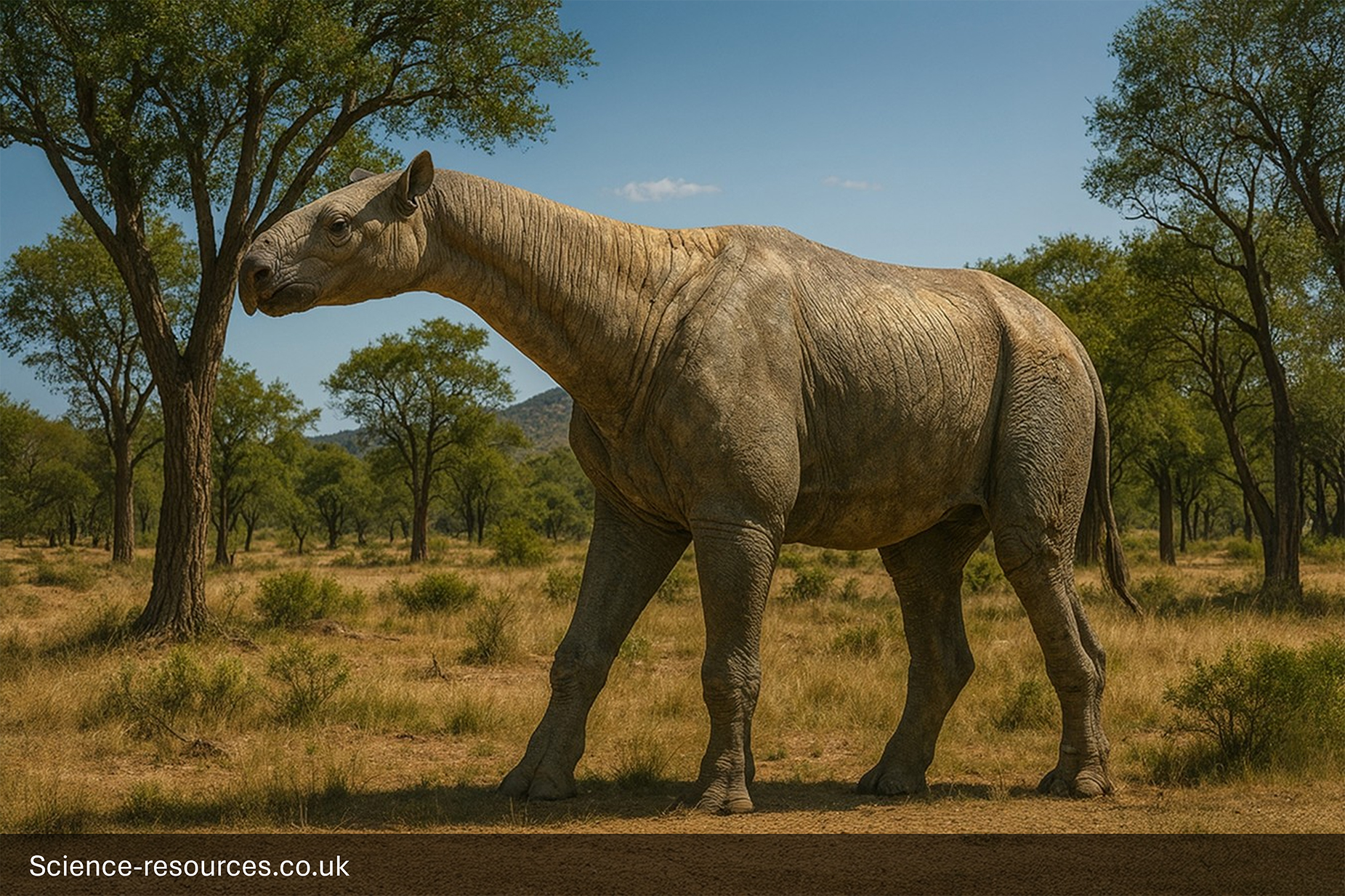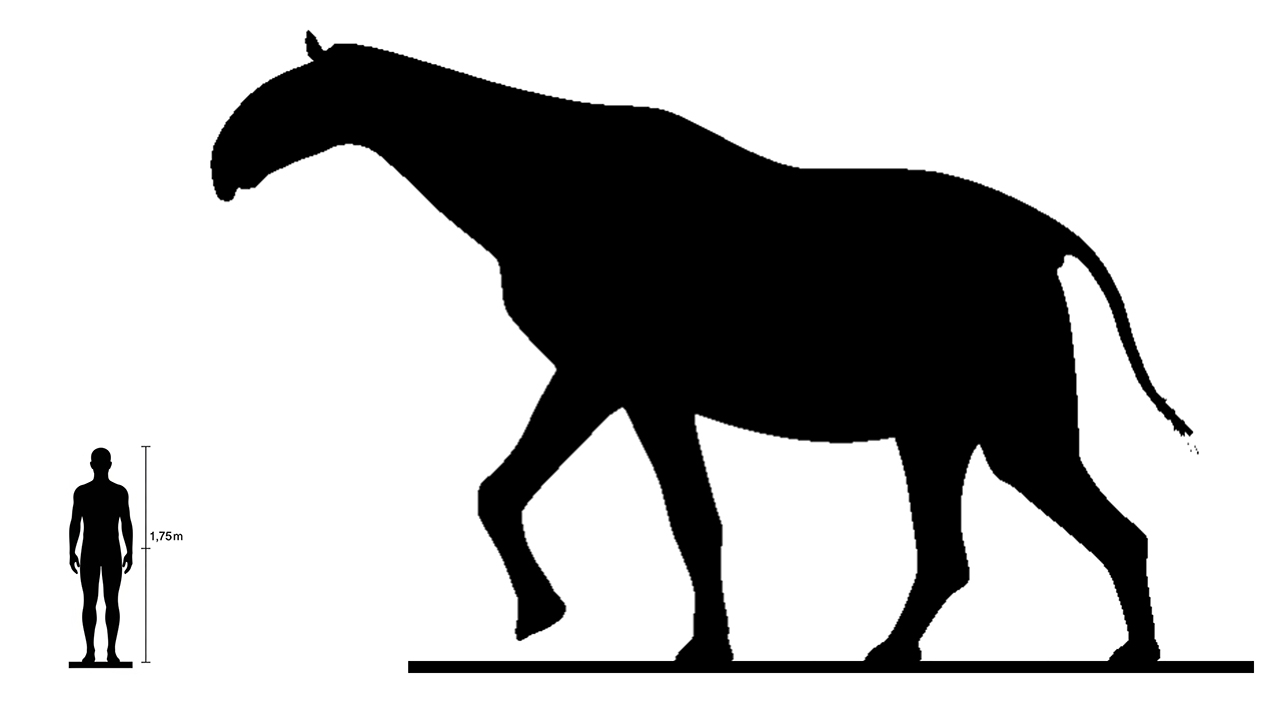Last updated: 4th August 2025
Extinct Animals: Indricothere | Paraceratherium
Indricothere (Paraceratherium), the largest land mammal ever to exist, living during the Oligocene. A hornless relative of the rhinoceros, with a long neck and massive body.
Indricothere (Indric Beast)
 Indricothere / Paraceratherium
Indricothere / Paraceratherium
Generative AI Notification: Some elements of this image have been created or enhanced using AI technology. To find out how we create all our prehistoric animals, click here.
What is Indricothere?
Indricothere, or Paraceratherium, was a genus of hornless rhinoceroses and is one of the largest land mammals ever to have existed.
How big was Indricothere?
It could stand over 5 meters (16 feet) tall at the shoulder and weighed up to 20 tons.
What did Indricothere eat?
As a large herbivore, it browsed on leaves, soft plants, and shrubs from trees, similar to a modern giraffe.
Indricothere appearance
It had a long neck and a hornless skull. Its size and shape resembled a gigantic, long-necked rhino.
Where did Indricothere live?
Fossils have been found in Eurasia, particularly in Central Asia.
Interesting facts
Despite its size, it was a gentle giant, living a solitary or small herd existence.

Indricothere Facts
Pronounced: in-DRIK-oh-theer
Name Means: "Indric Beast" (named after a mythical creature)
Length: Up to 8 meters (26 feet)
Height: Around 5.5 meters (18 feet) at the shoulder
Weight: Up to 20,000 kilograms (44,000 pounds)
Diet: Herbivore (Plants)
Time: Late Eocene to Early Oligocene Epochs (about 34 to 23 million years ago)
Fossils Found: Central Asia (notably Mongolia, China, and Kazakhstan)
Which family of animals did Indricothere belong to?
It was a member of the family Hyracodontidae, a group of extinct hornless rhinos.
What other animals lived at the same time as Indricothere?
It lived during the Oligocene epoch alongside other large mammals, including Entelodonts.
Indricothere FAQ
Q1: What was Indricothere?
A1: Indricotherium is an extinct genus of giant herbivorous mammals that lived during the late Oligocene to early Miocene epochs, around 34 to 23 million years ago. It is also known by the name Paraceratherium.
Q2: How big was Indricotherium?
A2: Indricotherium was enormous—estimates suggest it stood up to 5.5 meters (18 feet) tall at the shoulder and weighed between 15 to 20 tons, making it the largest land mammal known to science.
Q3: What did Indricotherium look like?
A3: It resembled a gigantic, hornless rhinoceros with a long neck and legs, allowing it to browse on tall vegetation. Its body was massive and barrel-shaped, supported by thick, column-like limbs.
Q4: What did Indricotherium eat?
A4: Indricotherium was a browser, feeding on leaves, soft plants, and shrubs from tall trees. Its height and long neck gave it access to vegetation other herbivores couldn’t reach.
Q5: Where have Indricotherium fossils been found?
A5: Fossils have been discovered across Central Asia, including regions of Kazakhstan, Pakistan, Mongolia, and China.
Q6: Is Indricotherium related to modern rhinoceroses?
A6: Yes, Indricotherium is part of the same family as modern rhinoceroses (Rhinocerotidae), though it lacked horns and was much larger.
Q7: Why is Indricotherium also called Paraceratherium?
A7: The name Paraceratherium is now considered the valid scientific name, while Indricotherium is a synonym. The naming history is complex due to multiple fossil discoveries and classifications.
Q8: Did Indricotherium have any predators?
A8: Due to its massive size, adult Indricotherium likely had no natural predators. However, young or sick individuals may have been vulnerable to large carnivores of the time.
Q9: How did Indricotherium move?
A9: Despite its size, it was likely a slow-moving but steady walker, adapted to roaming vast open woodlands and floodplains in search of food.
Q10: Why did Indricotherium go extinct?
A10: Its extinction may have been caused by climate changes that led to habitat loss, along with competition from other herbivores and evolving ecosystems during the Miocene.
You may also be intrested in:
- Extinct Animals: A-Z
- Dinosaurs: A-Z
Tags: How big was Indricothere, Indricothere, where did Indricothere live, how tall was Indricothere, what does Indricothere mean, Indricothere facts
Previous: Hyaenodon
Up next: Macrauchenia
© 2012 science-resources.co.uk. All rights reserved | Design by W3layouts
Extinct Animals: Indricothere | Paraceratherium
Indricothere (Paraceratherium), the largest land mammal ever to exist, living during the Oligocene. A hornless relative of the rhinoceros, with a long neck and massive body.
Indricothere (Indric Beast)
 Indricothere / Paraceratherium
Indricothere / Paraceratherium
Generative AI Notification: Some elements of this image have been created or enhanced using AI technology. To find out how we create all our prehistoric animals, click here.
What is Indricothere?
Indricothere, or Paraceratherium, was a genus of hornless rhinoceroses and is one of the largest land mammals ever to have existed.
How big was Indricothere?
It could stand over 5 meters (16 feet) tall at the shoulder and weighed up to 20 tons.
What did Indricothere eat?
As a large herbivore, it browsed on leaves, soft plants, and shrubs from trees, similar to a modern giraffe.
Indricothere appearance
It had a long neck and a hornless skull. Its size and shape resembled a gigantic, long-necked rhino.
Where did Indricothere live?
Fossils have been found in Eurasia, particularly in Central Asia.
Interesting facts
Despite its size, it was a gentle giant, living a solitary or small herd existence.

Indricothere Facts
Pronounced: in-DRIK-oh-theer
Name Means: "Indric Beast" (named after a mythical creature)
Length: Up to 8 meters (26 feet)
Height: Around 5.5 meters (18 feet) at the shoulder
Weight: Up to 20,000 kilograms (44,000 pounds)
Diet: Herbivore (Plants)
Time: Late Eocene to Early Oligocene Epochs (about 34 to 23 million years ago)
Fossils Found: Central Asia (notably Mongolia, China, and Kazakhstan)
Which family of animals did Indricothere belong to?
It was a member of the family Hyracodontidae, a group of extinct hornless rhinos.
What other animals lived at the same time as Indricothere?
It lived during the Oligocene epoch alongside other large mammals, including Entelodonts.
Indricothere FAQ
Q1: What was Indricothere?
A1: Indricotherium is an extinct genus of giant herbivorous mammals that lived during the late Oligocene to early Miocene epochs, around 34 to 23 million years ago. It is also known by the name Paraceratherium.
Q2: How big was Indricotherium?
A2: Indricotherium was enormous—estimates suggest it stood up to 5.5 meters (18 feet) tall at the shoulder and weighed between 15 to 20 tons, making it the largest land mammal known to science.
Q3: What did Indricotherium look like?
A3: It resembled a gigantic, hornless rhinoceros with a long neck and legs, allowing it to browse on tall vegetation. Its body was massive and barrel-shaped, supported by thick, column-like limbs.
Q4: What did Indricotherium eat?
A4: Indricotherium was a browser, feeding on leaves, soft plants, and shrubs from tall trees. Its height and long neck gave it access to vegetation other herbivores couldn’t reach.
Q5: Where have Indricotherium fossils been found?
A5: Fossils have been discovered across Central Asia, including regions of Kazakhstan, Pakistan, Mongolia, and China.
Q6: Is Indricotherium related to modern rhinoceroses?
A6: Yes, Indricotherium is part of the same family as modern rhinoceroses (Rhinocerotidae), though it lacked horns and was much larger.
Q7: Why is Indricotherium also called Paraceratherium?
A7: The name Paraceratherium is now considered the valid scientific name, while Indricotherium is a synonym. The naming history is complex due to multiple fossil discoveries and classifications.
Q8: Did Indricotherium have any predators?
A8: Due to its massive size, adult Indricotherium likely had no natural predators. However, young or sick individuals may have been vulnerable to large carnivores of the time.
Q9: How did Indricotherium move?
A9: Despite its size, it was likely a slow-moving but steady walker, adapted to roaming vast open woodlands and floodplains in search of food.
Q10: Why did Indricotherium go extinct?
A10: Its extinction may have been caused by climate changes that led to habitat loss, along with competition from other herbivores and evolving ecosystems during the Miocene.
Tags: How big was Indricothere, Indricothere, where did Indricothere live, how tall was Indricothere, what does Indricothere mean, Indricothere facts
Previous: Hyaenodon
Up next: Macrauchenia
© 2012 science-resources.co.uk. All rights reserved | Design by W3layouts